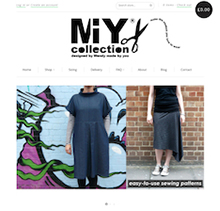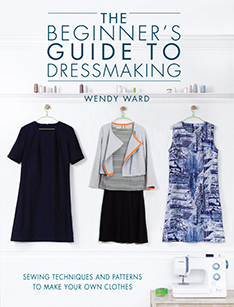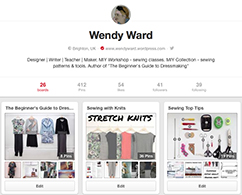 Photo © Julian Ward
Photo © Julian Ward
If you have just started to sew some of the language used in patterns, books and video tutorials can be a bit confusing. It’s not a secret language, you just need to learn a few technical terms and all will become clear. I hope this list will start to help!
Bias binding – continuous strip of fabric cut on the bias. Used on hems and seam allowances for a neat finish. Can be bought readymade in various widths or you can make your own. (Explanation of the bias in fabric here.)
Centre Back – the middle of the back of the body in a garment and pattern pieces.
Centre Front – the middle of the front of the body in a garment and pattern pieces.
Closed-end Zip – a zip which cannot be separated into two halves, where only part of a seam needs to open eg, the waist of a skirt.
Dart – a stitched fold of fabric used in certain areas of a garment to shape it around the contours of the body, usually found at the bust and waist.
Directional Print Design – also described as a one-way print or fabric “with nap” – a design that can only be used in one direction otherwise it would appear upside down.
Ease – in sewing refers to a slight excess fullness along one edge when joining a seam which needs to be distributed evenly (such as when setting-in sleeves). In patterns refers to the difference between the measurements of a finished garment compared to the actual body measurements.
Facing – layer of fabric on the inside of edges of a garment to finish the raw edge where a hem isn’t possible or not sufficient. Usually found at necks, on armholes of sleeveless garments on waists instead of a waistband and sometimes on hems.
Gathers – excess fabric brought together with parallel rows of loose stitching.
Grain / Grainline / Straight Grain – lengthways direction of a fabric, parallel to the selvedges. The grain of the fabric in the finished garment affects how it will hang and drape.
Haberdashery – sometimes called “notions”, a description that covers all the things needed to make a garment apart from the fabric.
Hem – a way of neatening the edge of a piece of fabric.
Interfacing – fabric which is attached to the wrong side of your fabric to stiffen and strengthen areas of strain, wear and tear or to help keep their shape. Most often used in waistbands, button stands, collars and cuffs. Can be ironed-on or sewn in. The fusible or iron-on version is also often called Vilene – this is simply the brand name.
Notches – marks on the edge of patterns pieces to help match seams accurately.
Open-ended zip – a zip which can be separated into two halves, used where garments need a complete opening eg. in the front of jackets.
Pile – Raised surface on a fabric, for example velvet.
Pressing – different to ironing, which moves your iron repeatedly across fabric or a garment to remove creases, pressing uses your iron slowly in specific areas to flatten and smooth your sewing, eg. seams, hems, darts and makes your sewing look much neater and more professional. Pressing should always be done on the wrong side of the fabric and in certain circumstances with the aid of a pressing cloth.
Pressing cloth – piece of muslin placed between fabric and iron when pressing to protect the fabric – allows more heat to be passed to the fabric without scorching it and so means better pressing.
Raw edge – Cut edge of fabric that should be neatened to prevent fraying.
Right side – the side of the fabric that ends up on the outside of the garment, often abbreviated in pattern instructions to RS.
Seam – stitching which joins together pieces of fabric.
Seam allowance – the distance between the cut edge of the fabric piece and the seamline.
Seamline – position of the seam stitching along a piece of fabric.
Selvedge – neat self finished edges on fabrics that runs in the lengthwise direction along the grainline, useful in identifying the straight grain.
Set-in sleeve – a method of attaching a sleeve to a garment without any gathers where the sleeve and the body of the garment are joined first.
Sleeve head – top curved section of a sleeve which is stitched into the armhole of the garment, this is where most of the ease is found in a sleeve.
Tacking stitch – hand running stitch used to temporarily hold fabric together accurately ready for machining or to transfer pattern markings to fabric which need to be visible on the right side.
Toile – a sample or practice garment made calico to try out the fit of a pattern and make any necessary corrections.
Understitch – machined straight stitch which helps seamlines sit neatly on the inside of a garment, most often used along facing seams.
Vilene – see Interfacing.
Waistband – separate piece of fabric used to finish the waist of trousers and skirts.
Warp – threads that run along the length of woven fabric (these are usually the strongest threads).
Weft – threads that run along the width of woven fabric.
Wrong side – the side of the fabric that ends up on the inside of the garment, often abbreviated in pattern instructions to WS.
A final note………..
Pattern instructions may not always tell you to pin and tack seams before sewing them. If you haven’t done lots of sewing it is good practice to pin and tack first. It will make your work easier to machine, much neater, more accurate and ultimately quicker, tacking = no unpicking!



















Pingback: My Month on Social Media – April 2017 | Wendy Ward